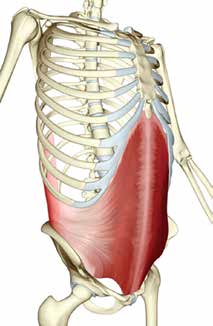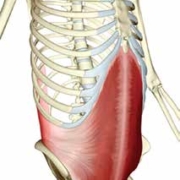THE ROLE OF THE TRANSVERSE ABDOMINIS AS A MAJOR CORE MUSCLE
Each and every day, muscles and joints are needed to provide the ability to perform purposeful movements. These movements can be simple, like rolling in bed, or more complex, like performing high level athletics.
What are the differences between muscles and why is one used over the other?
When it comes to muscles, there are multiple layers in many areas of the body. Some muscles contract and provide more mobility, while others provide more stability. Superficial muscles commonly are longer or wider muscles and when they contract, they are more ballistic in nature, providing support for purposeful movements.
Deeper muscles tend to be the closest to the bones. They are the muscles that provide more stability to the body.
 Creating a stable platform for the body allows for more protection against injury while helping to guide the body more closely for motion. Some muscles stabilize while other muscles perform the movement desired.
Creating a stable platform for the body allows for more protection against injury while helping to guide the body more closely for motion. Some muscles stabilize while other muscles perform the movement desired.
When discussing the core, it is often thought that it is the abdominal area only. It is actually much more than that. The core consists of multiple pairs of muscles on either side of the body in the scapula, abdominal, back, and hips regions. These muscles, when firing properly, coordinate together to allow for activities to be performed in a safe manner.
It is common when there is an injury to the back region, however, for the muscles not to fire properly. The deeper muscles that stabilize commonly have altered firing patterns, thus proper stabilization while performing an activity may be altered. This occurrence over time will prove to be problematic. For example, it has been documented repeatedly that the transverse abdominis (TA) in the abdominal area is active even before an activity is performed. There is a lag, or sometimes little contraction so the stable platform is now not so stable.
Inefficient transverse abdominis muscles that do not activate properly may lead to a multitude of problems in the spine and even in the hip area. This muscle originates off of the ribs (as high as the 7th rib) and wraps around the front abdominal area down to the pubic bone, then attaches to the center of the abdomen (at the linea alba).
It is the deepest anterior muscle, so it has a major stabilizing role in protecting the organs, spine, and pelvis. It is the coordination of the abdominal, pelvic floor, diaphragm, and back muscles that keeps the trunk and all of its contents more safe.
Activating the TA plays a key role in keeping the body supported properly. When it contracts around both sides, since the muscles’ fibers run more horizontally, it flattens the abdomen, giving support to the spine and securing the organs.
Learning to activate this muscle can be tricky, because it is very deep. More superficial is the rectus abdominis (often referred to as the “6 pack muscle”), the external and internal obliques, plus any fat that is superficial to the organs.
To contract the TA, the best way is to lay down on the back and place your fingers just on the inside of the front pelvis. Do not perform any type of sit up, as this will only guide you to be feeling the obliques and rectus abdominis. With palpation, think about drawing your navel in toward the spine. There should be no big pelvic or diaphragm movements with this activity.
It takes time to actually get the motion right. You will feel the tightness under your fingers. This is how you cognitively activate this muscle.
Focus on tightening the muscle while breathing normally. As you practice this, it will get easier and you will realize that it indeed feels different from other abdominal exercises that you have done.
Once you’re able to contract the TA tightly, moving one arm up and down while contracting this can start to get the TA into its stabilizing role as you move. Then, begin moving the leg while keeping the TA contracted and stabilized.
This is just the beginning of the TA journey. Getting it to work in varied pelvic and back positions is extremely important. Combinations of movements with this muscle re-education will prompt the TA to fire more naturally so that soon, you won’t even have to think about it.
FOCUS AND PERSEVERE…
TO YOUR HEALTH!
Fitness Together: 335 14th Avenue South, Naples, FL I 239.263.9348 www.fitnesstogether.com/naples





Leave a Reply
Want to join the discussion?Feel free to contribute!